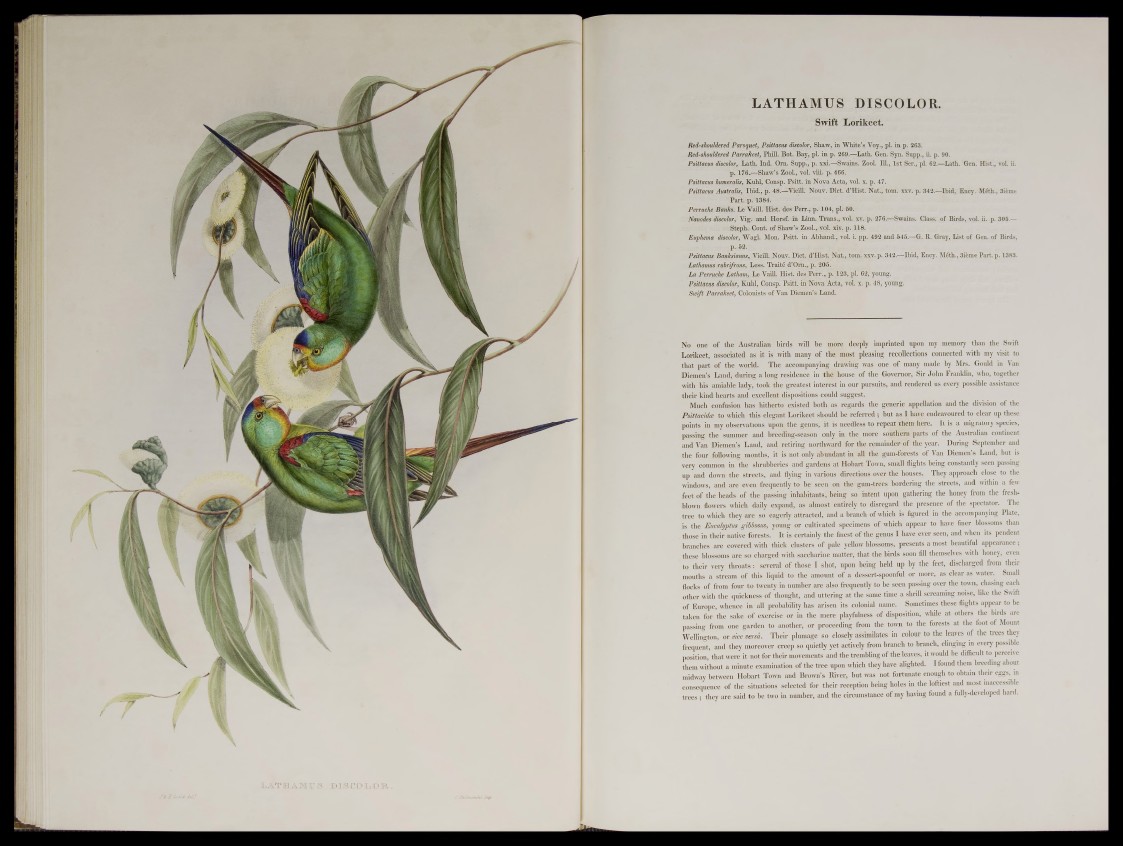
1LA.T H A M Ü S . Ä S C O L O R
LATHAMUS DISCOLOR.
Swift Lorikeet.
Red-shouldered Paroquet, Psittacus discolor, Shaw, in White’s Voy., pi. in p, 263,
Red-shouldered Parrakeet, Pb^ll, 13 ot. 13av,, pf'uu p ^69 —lath. Gian. Syu. Supp., n. p. 90.
Psittacus discolor, Lath, Ind. Ora. Supp., p. xxi.-—Swains. Zool. HI., 1st Ser., pi. 62.—Lath. Gen. Hist., toL it
1 1 'n^ lJy. - S);~aw.'s* 3£uol\ jfj 4^hT*.
Psittacus hurncrqlvs, tip, Igutt in Nova Acta^vol^x p 47
NouvSDict.'d^HistrNah, tom,XXV. p.* :i42.^-lbidg Ency. Mtth., 3ieme
Permche Banks: plbhl).
Nanoies discolor.: ltig3"fa3ttl'Milojaf.-'.ljx Linn.rlAa41s.5 yoL xyop,-.276o^Sw aitis. Ciaas, of Birds, vol. ii. p. 305.—
Steph. Cont. of Shaw’s Zool., vol. xiv. p. 118.
Euphema in’j Vldyrml^ ,nP iy pp. Jp -2 am] 54u.- tG.R. Gray,* lis t of Gen. of Birds,
P- 62- :
Psittaayt Ilanksiams, Vip.ill- Nonv. O ^ ^ S fe ^ f c p jg . tm S A r,n ,342.—Ibid. 'Ency. Meth, 3ifeme Part. p. 1383.
J.athanws ryhrifroru, L ess. Traite d’Orn., p. 205.
La Perryc/ic Lathavi:rhp -Vaill 11l-I dmdTi ri mj J 1 young,
Pnitdaut. dural!*, ‘lx V-il I in Nova Acta, vol. X. p. ‘•’V}™«? ’
Swift Parrakeet, Colmapj^ oft-Van ■B^^SSBandt
Np one o f the Australian Ktffi will be more deeply wngrsntgjj upon my memory than the Swift
LfiSkeit, associated as it is with 'm a n® ® the'most Igjensing. recollections connected with my visit to
tjjat part of the world.' Tl^^eampanYiugj d rawmg was on£\of many pjadp hy Mrs. Gould in Van
PienmnV Lan®during a lon^resi^gpee in ■thlji'bouse ^ fttg o g o v e rn o r, Sir Joljn Franklin, who, together
with, hie ami?blg'lpdy, took tbaj greatest intd r j ^ ^ f f i ^ Rursujis, and rendered unfivery possible assistance
their kind hearts and excellenE_disn9sitiOTS,goyld suggest.
g p S n c h confusion hag hith®to existed h a tJ J ^ re g a rd s the gejmric appellation and the division of the
PsittacidiB ,tg which'this elegant Lorikeet sh ^M b e re ferred; b.ut have,endeavoured to cleanup these
points m my pttservationso uporysthe genus, iy(h> nemlles^^o repeat them here. If is a migratory species,
passing the summer and breeding-season q nlyjn the^ more soupforji‘parts of the Australian continent
ajuf Vsb Diemen’s Land, andsigdring n o r th ^W o r ith e remaindered the year. During J>|pt|jttber and
.tW.Four Mtawing.months, it is not only abundant in all tb^gum-forests Van Diemen’s Land, but is
very cpnppQP in tfpt shrubberies and gardhulndl I Iobiu*t,-To\yn,;.*unallmglUs being constantly seen passing
up a » d d g y S th e streets, and flying in vimmis directions S g p T k o u s e a , They approach close to the
windows, and, .ate even-frequently ta,,hej sef e (M&d^guu^,eea^flgerffigi:tlie. streets, and within a few
fte t of the heads of the passing inhatotantssjmeing so intent ugsn gatbnripg, the-honey from the fresh-
blown floiyers which d^ysamepand, as'abngst entirely to d ^ ^ r d f j b e presence o fjMsp ec ta to r. The
A s s to whyV they are so eagerly attra c ted ,p d fa branch ofwhb&% figged in the |^om p an y h ^ |P la te ,
Is the Eucalyptus gihham , young or cultivated specimens Atg^bich" appear tp ‘b g e’ 6ner blossonw than
those in their native forests. I t is certainly- th e finest of the genus I have ever seen, and w h e a ts pendent
branches are ccreered with thick dusters of pale ydlow blossoms, presents, a' nKgfrbei$iful appearance ;
these blossoms are so charged with saccharine matter, that ftfrlsgte sgonffiU themsdves.witlrhoney, even
’to their very th ro ats: several of those ! shot, u p o n p i® ^ K u p by t^e feel,.discharged from their
mouths a stream of this liquid to the amount o f i " °S I?QfP, a sic i^ g ^ s water. Soglt
flocks of from four to twenty in number are also frequently to'he seen passing oven the town, chasing each
other with the quickness of thought, and: uttering at the, same*(jme a sJidJUqrwning noise, like the Swift
o f Europe, whence in all probability has arson ite Bfpe. Sometimes these flights appear to be
taken for the sake of »y»-™«- or in the mere playfulness of d&ggsigs^ while at others the birds are
paqalnp. from <®e garden -to another, or proceeding f ew the:'A om’ to the forests at the foot of Mount
Wellington, or sige m d . Their plumage so dosdy # im ila te sg jp o tow . to the leaves of the trees t^yr
frequent, and they moreover creep so*quie^y yet actively from branch to branch, chbgtog in every possible
position, that were it not for their movements and the tsgmbjmg o f thef eaves, it would be difficult to perceive
them without a minute examination of the tree upon which they have alighted. I found them breeding about
michvay between H o b a r tllS n and Brown’s River* tod was not fortunate enough to obtain th d r egg«, to
consequence of the situations selected for their reception being holes in the loftiest and most inaccessible
tre e s ; they are said to be two in number, aud the circumstance of my'haying found a fully-developed hard.